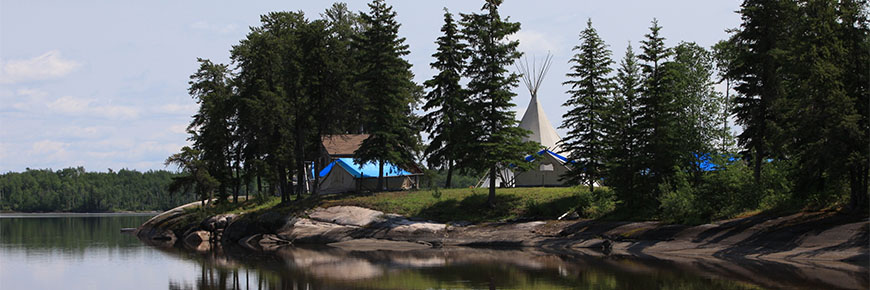
A community cultural camp on Weaver Lake. © Pimachiowin Aki Corporation. Author: Hidehiro Otake.
Pimachiowin Aki
Manitoba and Ontario
Date of Inscription: 2018
Pimachiowin Aki, which is Anishinaabemowin (Ojibwe) for “the land that gives life,” is Canada’s first mixed World Heritage property. Blending both natural and cultural heritage values, this large intact boreal forest ecosystem under Indigenous stewardship, is an exceptional example of the indivisibility of the natural environment and the cultural identity and traditions of Indigenous peoples.
Justification of outstanding universal value
Pimachiowin Aki was designated as a World Heritage site by UNESCO’s World Heritage Committee under the following criteria:
Criterion (iii)
Pimachiowin Aki provides an exceptional testimony to the continuing Anishinaabe cultural tradition of Ji-ganawendamang Gidakiiminaan (Keeping the Land). Ji-ganawendamang Gidakiiminaan guides relations between Anishinaabeg and the land; it is the framework through which the cultural landscape of Pimachiowin Aki is perceived, given meaning, used and sustained across the generations. Widely dispersed across the landscape are ancient and contemporary livelihood sites, sacred sites and named places, most linked by waterways that are tangible reflections of Ji-ganawendamang Gidakiiminaan.
Criterion (vi)Pimachiowin Aki is directly and tangibly associated with the living tradition and beliefs of the Anishinaabeg, who understand they were placed on the land by the Creator and given all they need to survive. They are bound to the land and to caring for it through a sacred responsibility to maintain their cultural tradition of Ji-ganawendamang Gidakiiminaan (Keeping the Land). This involves ceremonies at specific sites to communicate with other beings, and respect for sacred places such as pictograph sites, Thunderbird nests, and places where memegwesiwag (little rock people) dwell, in order to ensure harmonious relations with the other spirit beings with whom Anishinaabeg share the land, and to maintain a productive life on the land.
The beliefs and values that make up Ji-ganawendamang Gidakiiminaan are sustained by systems of customary governance based on family structures and respect for elders, and through vibrant oral traditions that are tangibly associated with intimate knowledge of the land through named places that serve as mnemonic prompts, including locations of resources, travel routes, and the history of Anishinaabe occupation and use.
The size of Pimachiowin Aki and the strength of these traditions make it an exceptional example of a belief that can be seen to be of universal significance.
Criterion (ix)Pimachiowin Aki is the most complete and largest example of the North American boreal shield, including its characteristic biodiversity and ecological processes. Pimachiowin Aki contains an exceptional diversity of terrestrial and freshwater ecosystems and fully supports wildfire, nutrient flow, species movements, and predator-prey relationships, which are essential ecological processes in the boreal forest. Pimachiowin Aki’s remarkable size, intactness, and ecosystem diversity support characteristic boreal species such as Woodland Caribou, Moose, Wolf, Wolverine, Lake Sturgeon, Leopard Frog, Loon and Canada Warbler. Notable predator-prey relationships are sustained among species such as Wolf and Moose and Woodland Caribou, and Lynx and Snowshoe Hare. Traditional use by Anishinaabeg, including sustainable fishing, hunting and trapping, is also an integral part of the boreal ecosystems in Pimachiowin Aki.
Full description
The site comprises the traditional lands of four Anishinaabe communities – Poplar River, Bloodvein River, Pauingassi and Little Grand Rapids First Nations – as well as adjacent protected areas, including Atikaki and South Atikaki Provincial Parks in Manitoba, and Woodland Caribou Provincial Park and Eagle-Snowshoe Conservation Reserve in Ontario.
More Information
Related links
- Anticosti, Quebec
- Tr’ondëk-Klondike, Yukon
- Writing-on-Stone / Áísínai’pi
- L’Anse aux Meadows National Historic Site
- Nahanni National Park Reserve
- Dinosaur Provincial Park
- Kluane / Wrangell-St.Elias / Glacier Bay /...
- Head-Smashed-In Buffalo Jump
- SG̱ang Gwaay
- Wood Buffalo National Park
- Canadian Rocky Mountain Parks
- Historic District of Old Québec
- Gros Morne National Park
- Old Town Lunenburg
- Waterton-Glacier International Peace Park
- Miguasha National Park
- Rideau Canal
- Joggins Fossil Cliffs
- Landscape of Grand Pré
- Red Bay Basque Whaling Station
- Mistaken Point
- Date modified :